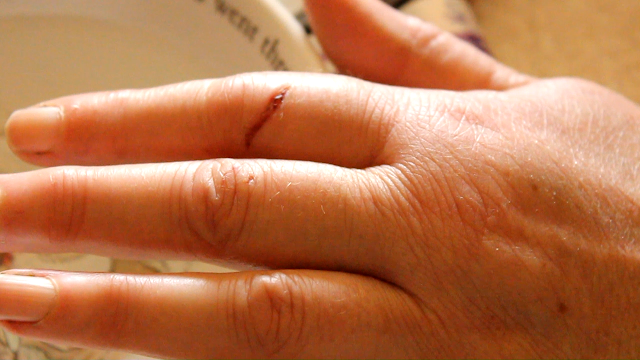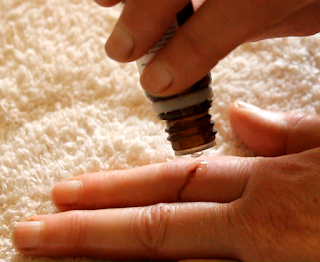Normally if I was using a very sharp blade in the garden I would wear thick leather gloves but on this occasion I didn't and ended up with a deep cut. It was both bleeding and painful so I used a warm water bath into which I added two essential oils, which I always have on hand in the kitchen in case of emergency.
Andy, my husband, is trained in first aid but if you are at all unsure about the nature of a cut or wound seek medical attention.
If you have seen any of my poultry films, you will know that this is also a formula I use to clean up wounds on poultry too. It is easy to make and also just as importantly, easy to source, as the two essential oils used are two of the commonest.
Make sure you buy pure essential oils, as a simple rule, a good oil will leave no stain on fabric or paper.
As an added bonus, even when organically certified, these two oils are still inexpensive, both costing under 8 dollars and as each contain 250 drops per bottle and I only use a few drops per treatment, this is not only an effective but also a low cost way of cleaning wounds, stopping pain and repairing skin.
Make sure you buy pure essential oils, as a simple rule, a good oil will leave no stain on fabric or paper.
As an added bonus, even when organically certified, these two oils are still inexpensive, both costing under 8 dollars and as each contain 250 drops per bottle and I only use a few drops per treatment, this is not only an effective but also a low cost way of cleaning wounds, stopping pain and repairing skin.
The Essential Oils
True Lavender - Lavandula angustifolia
Properties: Powerful healer, for wounds, burns, cuts, abrasions and other skin conditions, as well as a painkiller, antiseptic/antibacterial and immune system support, calming.
A small bowl of warm distilled or mineral water
Tea Tree - Melaleuca alternifolia
Properties: Powerful broad spectrum anti-bacterial, pain-killer, immune system support and fights skin infections.
Materials
5 drops of EO of True Lavander
2 drops of EO of Tea Tree
Microporous tape
Organic cotton wool (25% of the World's pesticides are used in the production of cotton)
An ice lolly stick or short piece of fruit crate wood
Method
Drop the essential oils into the water, as oils they will naturally remain on the surface of the water so swish the water around to cause them to break up.
Place the finger, in the water for a minute or so. In the case of larger wounds you can gently dab the area with a piece of cotton wool dipped in the wash.
For an added pain-killer and disinfectant, add one drop of lavender from the bottle straight onto the wound.
Cover with a cotton wool pad and if like me you have a wound that may come open with movement, then make a splint to support the wound using an ice lolly stick. Fix the whole dressing together with a length of microporous tape.
In my case you will see in the film below, the essential oils dealt with the pain and cleaned up the wound.
Now if you'd like to sit back and watch the film:
and also if it will be of use, how to treat cuts and wounds on poultry:
....and next time Andy mentions he sharpened the sickles, I'll take better notice..and care.
If you've enjoyed this post then please feel free to share it, ask questions and/or comment.
Hope to see you here again for another recipe from an old farmhouse in Normandie,
Sue
ADDITIONAL RELATED WRITTEN ARTICLES:
Treating wounds in poultry with this same wound washTreating a badly infected wound on a pigeon with Tea Tree essential oils and French green clay
Return to 'WHAT'S ON THE MENU' for more Simply Organic Recipes
© 2016 Sue Cross








